I love taking long-time exposures, so I wanted to dedicate an article to this topic. But how to begin? I sat down and racked my brain. Tell you what’s so special about night photography? Mention the difficulties, explain the challenges? Try to give technical advice? Talk about the influence of the weather? Well… In the past, I already discussed these issues in my article about night photography on CineStill film. Better not to repeat all of this. Eventually I decided, I would venture a different approach this time. So I went spelunking my Lightroom catalogue and chose 18+1 frames I wanted to present. The oldest image dates back to 2016, the newest one is from early spring this year. You are now going to read a short story on each photograph.
The images were shot with different cameras and lenses, but all on the same film stock family: Kodak Portra. (Roughly three-quarters on the ISO 400 variant, the rest on the 160 and 800 alternatives.) After several posts with black and white photography, the colors return. Please consider this piece as a love letter to the night and to Kodak Portra.
Image #0 (Above): The One with Calder’s Artwork
This photograph ranks among the first ones after my re-entering of the film world. And it is definitely my first long-time exposure on film. Ever.
When I started out with film again, I exclusively shot buildings. In doing so, I restricted myself to specific conditions (homogeneously overcast sky, dry weather). Because of these (unnecessary) restrictions, I couldn’t take photographs as often as I wanted to. A Sunday in December 2016 had been a mess of rain showers – spare time but no photo possibilities. To my luck, this changed in the evening. The rain left and a misty atmosphere remained. I decided to look for a nice subject in my neighborhood and came across these red “bulls”. American sculptor Alexander Calder created this work in 1971. It bears the name “Hallebardier”. Though not particularly dark, slow Portra 160 demanded an exposure time of about 15 minutes.
Equipment: Canon EOS 1N, Canon TSE 24mm f/3.5
Image #1: The One with the Shining Garage
On this occasion, I met my girlfriend after work. To be precise: she had to work this day, I had a day off. Around 4 o’clock, she appeared at gate. We decided to have a stroll through the neighborhood, as the sunny day already gave way to the night.
On the site of a former machine and boiler factory we stumbled across this garage. The light from the inside was glowing through the window facade, illuminating the old-ish Mercedes station wagon parked in front of the house. Through the open door I could see some mechanics running around. I rushed to take my photograph without causing a stir. Not in mood for these “Excuse me! What are you doing here?” type of conversations.
Equipment: Leica Leicaflex SL2, PA-Curtagon 35mm f/4
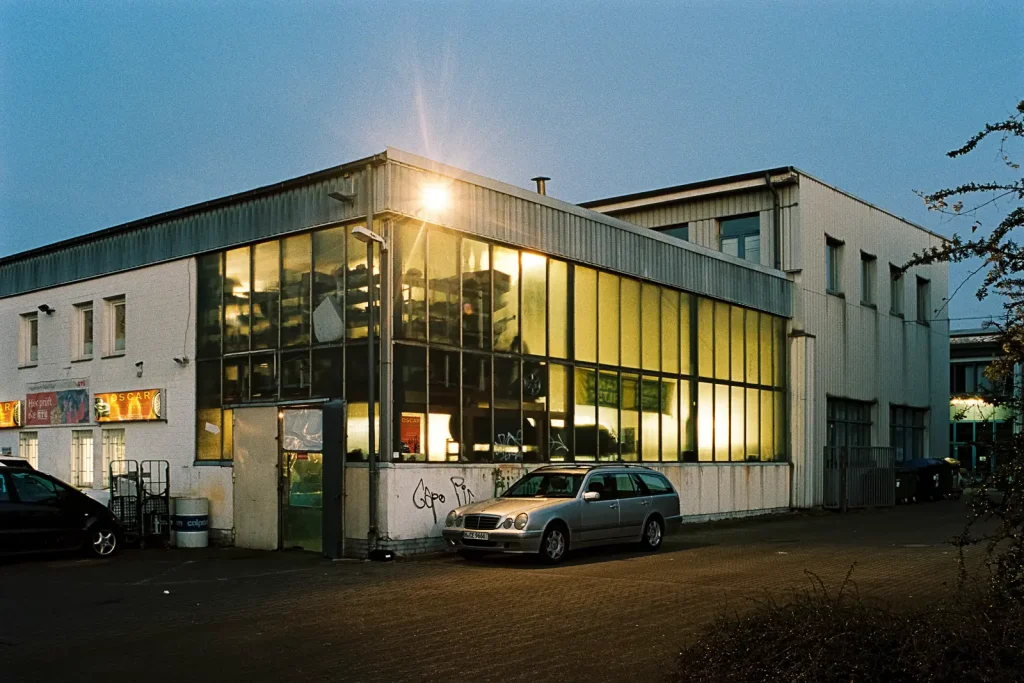
Image #2: The One with the Green Windows
Sometimes, the night provides strange lightning conditions you wouldn’t encounter during the day. In a business park I found a rather boring administration building of a small rubber company. At least a brick building, which I prefer over its sad companions covered in grey-ish plastic panels. But the special feature stood right next it. An adjacent furniture store illuminated the scene with its green neon signs. The green glow didn’t affect the facade that much, but the white window blinds. Now mix this green with the street light’s yellow in the foreground and the reddish reflecting clouds. And voila! You got a strange set of colors.
Equipment: Leica Leicaflex SL2, PA-Curtagon 35mm f/4
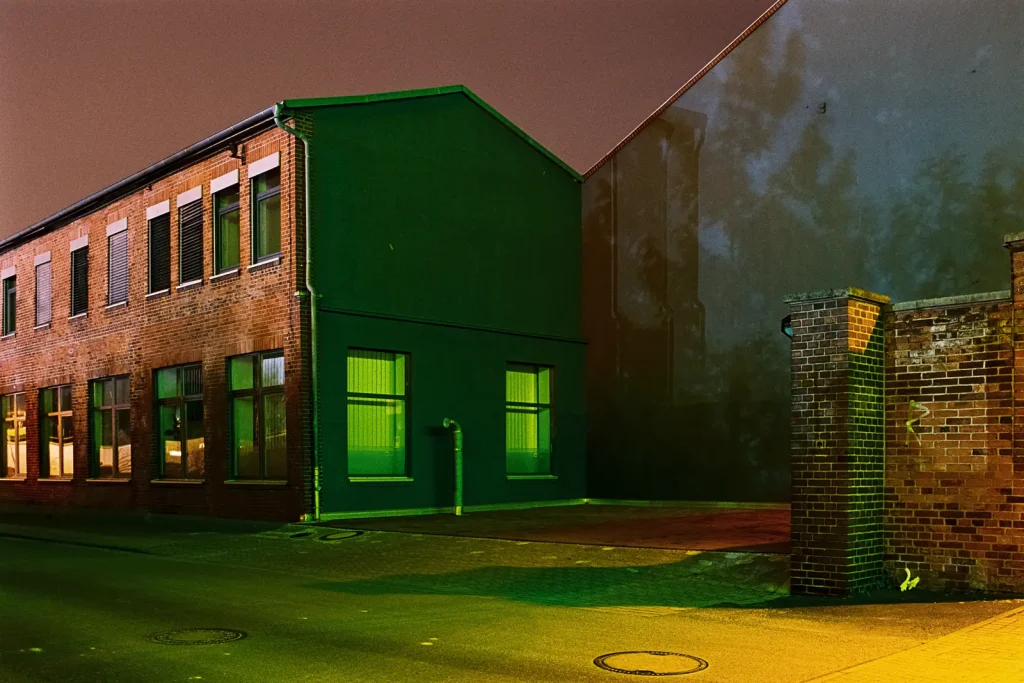
Image #3: The One with the Abandoned Office Building
Probably my shortest photo trip in terms of distance: the spot where took this shot is located less than 200 meters away from my home. Derelict places rank among my favorite subjects, so I have developed a radar for them during the years. This time, it was almost too easy to find.
Fluorescent lamps caused the blue-greenish tint of the facade and soil. What used to be a regular effect with daylight-balanced color negative film has become increasingly rare lately. LEDs have replaced most of the fluorescent lamps, they are about to die out. Much to my regret, as I like these sometimes surreal colors.
I remember this long-time exposure to last 15 to 20 minutes. So it was probably not the shortest photo trip time-wise.
Equipment: Leica Leicaflex SL2, PA-Curtagon 35mm f/4
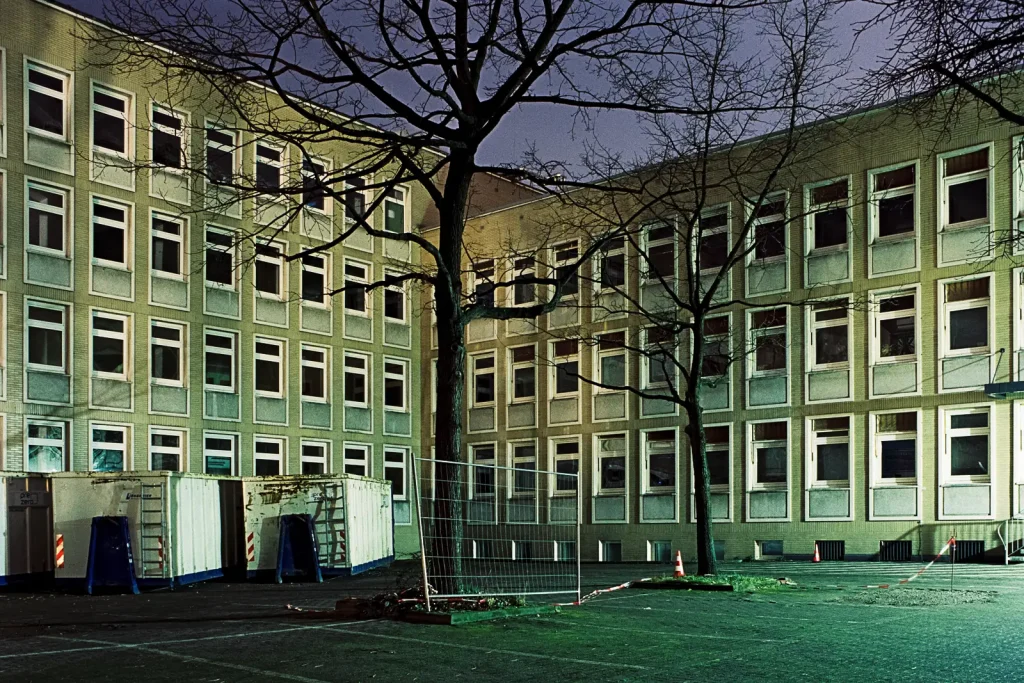
Image #4: The One with the Subtle Neon Sign
A monument! A religious cult site! No, it it’s neither this nor that. I suppose, the only purpose of this structure is to attract customers. Sometimes, even an unpretentious hardware store can provide some nice photo opportunities.
This pavilion thing stands right beside an intersection. The tight space in front of it forced me to reach for my sharpest weapon: the 17mm lens. Its short focal length in combination with the short distance between camera and subject resulted in a dramatic perspective. But handle with care: if the camera is not perfectly leveled, this lens is going to reveal it. A slight misalignment and the harmony of lines is gone. For two reasons, I chose a rather short exposure time of just three minutes. First, the red light was really bright. Secondly, I wanted to catch the next tram. This lead to a largely pitch black sky – however, there is a faint blue-ish glow just behind the shelter, which I really like.
Equipment: Canon EOS 1N, Canon TSE 17mm f/4
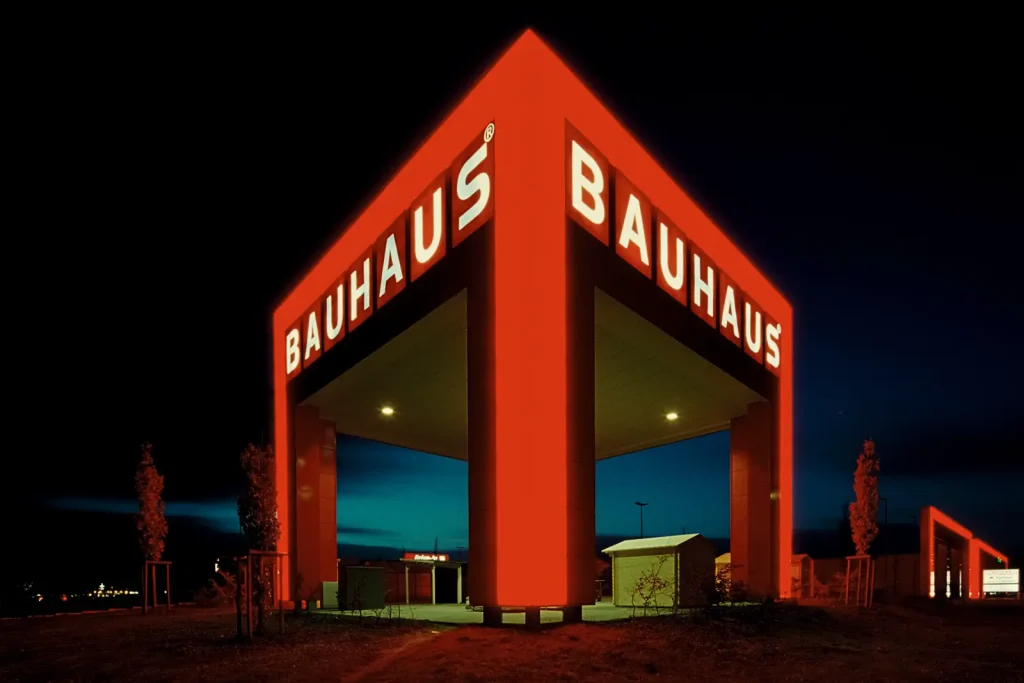
Image #5: The One with the Red Apartment Tower
A great side effect of the neon lights shown in the previous image: the red light also illuminated its surroundings. But first, back to the beginning.
Laatzen is small town located in the south of Hannover. Large apartment complexes from the 1970s shape the cityscape. Many times before, I had seen these buildings from the train. Definitely worth a photo walk, I always thought.
When I arrived at this area, the sun was still shining. I walked by the apartment tower and took a first photo. It seemed solid – but nothing special. Not finished yet, better wait for the blue hour. Well, the blue hour. Oftentimes, it turns out to be a tricky beast. At first, you have to wait… and wait… and wait (I can be so impatient!). When the window eventually opens, things happen fast. The light conditions change quickly, exposure times become longer and longer. We film shooters have to deal with the film’s reciprocity failure, which narrows the window even more. Before one knows, exposure times reach the regime of 10, 15, or even 30 minutes. Blue hour is over…
Back to Laatzen. Meanwhile, I had scouted several other locations before I finally returned to this tower. As I arrived there less than an hour later, the scene had changed dramatically. The sun had set, a fast moving cloud layer covered the sky. However, the coolest thing was the reflection on the building’s facade. The tower reminded me of red glowing steel.
Equipment: Canon EOS 1N, Canon TSE 24mm f/3.5
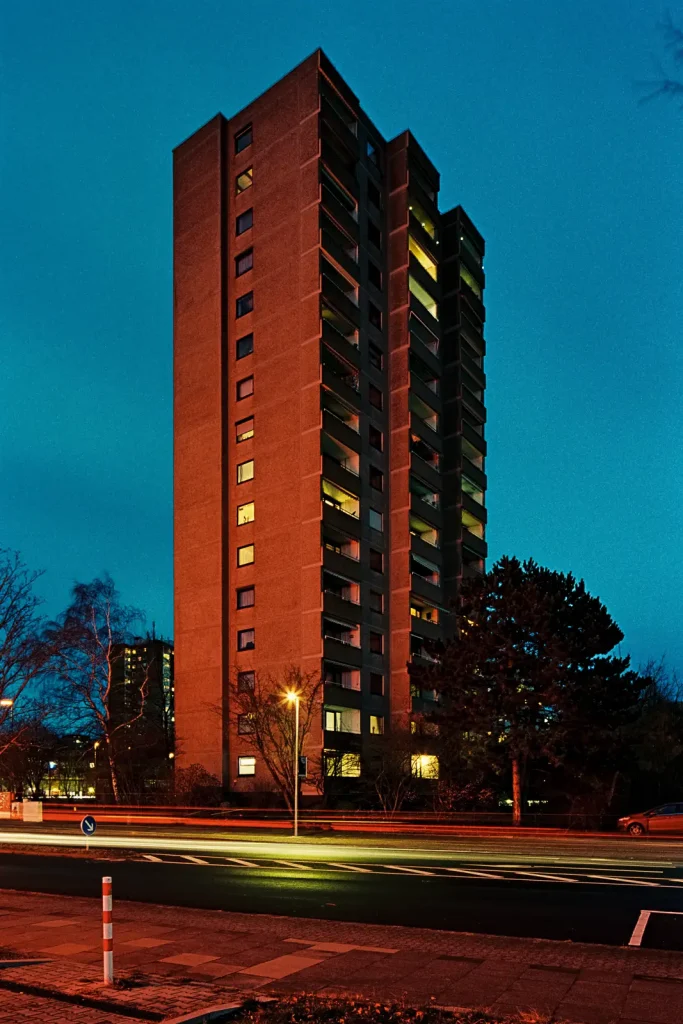
Image #6: The One with the Hidden Summer House
Allotments are called “Schrebergärten” (Schreber gardens) in Germany. Cute little houses, sometimes hidden behind dense hedges – they often leave the impression I have entered a fairy-tale.
Strolling around, I spotted this scenery from a nearby road. The night had settled in, though dusk wasn’t completely over at this time. It had been a mild but wet day in January. Maybe that’s why the illuminated windows gave this house an endlessly cozy appearance. I took a few steps towards the house to get a better sight. Positioned the tripod, powered up the camera and took aim. “Oh please,” I thought “don’t let somebody look out the window now and discover me! This is gonna be awkward to explain…”.
On this very day, my new Mamiya went on its maiden voyage. I had read the manual before, but of course I wasn’t familiar with the complex apparatus yet. Fiddling with the unknown camera in the dark, I could have kicked myself in the ass. Luckily, the illuminated window was bright enough to make the autofocus work. I stopped down to f/5.6 to allow the camera some focusing error – worked.
Equipment: Mamiya 645 AFD, Mamiya 80mm f/2.8
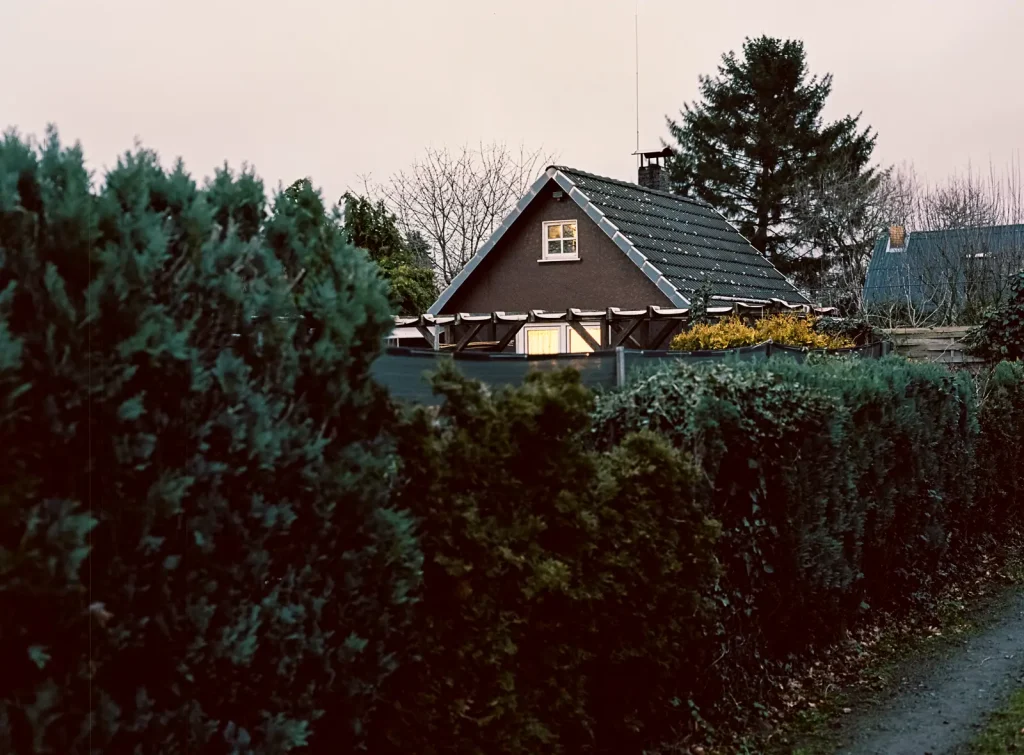
Image #7: The One with the not so Cozy House
The story of my outing first with the Mamiya continues with exactly this photograph. It shows another cabin, adjacent to one depicted in image #6.
A delicate situation: I struggled with the camera, again! This time, my standard cable release caused a headache as it wouldn’t fire the camera. I have to mention, the Mamiya allows for two different cable releases. You can either use a standard one, which has to be screwed into the shutter release button. Or you employ an electronic, proprietary one, plugged into a dedicated port (very pricey accessory on Ebay!). As I couldn’t make my cable release work, I navigated through the manual on my phone. Bulb Mode? Check. Mirror in up position? Check. Focus set to manual? Also check. Still, no success…
At least, I discovered the Time Mode while browsing through in the manual. In this mode, you press the shutter release once to open shutter. Some seconds later, the camera powers off itself – bye! Handy for long-time exposures, as the apparatus doesn’t eat through the batteries (in contrast to the regular bulb mode). When you think it’s enough, simply turn the mode dial to the X position – shutter closes. Applying this strategy, I was able to keep the shutter open for more than 10 minutes without the cable release. (And, of course, without pressing the button myself for 10 minutes.) Thank you, Time Mode. You saved my image.
Equipment: Mamiya 645 AFD, Mamiya 80mm f/2.8
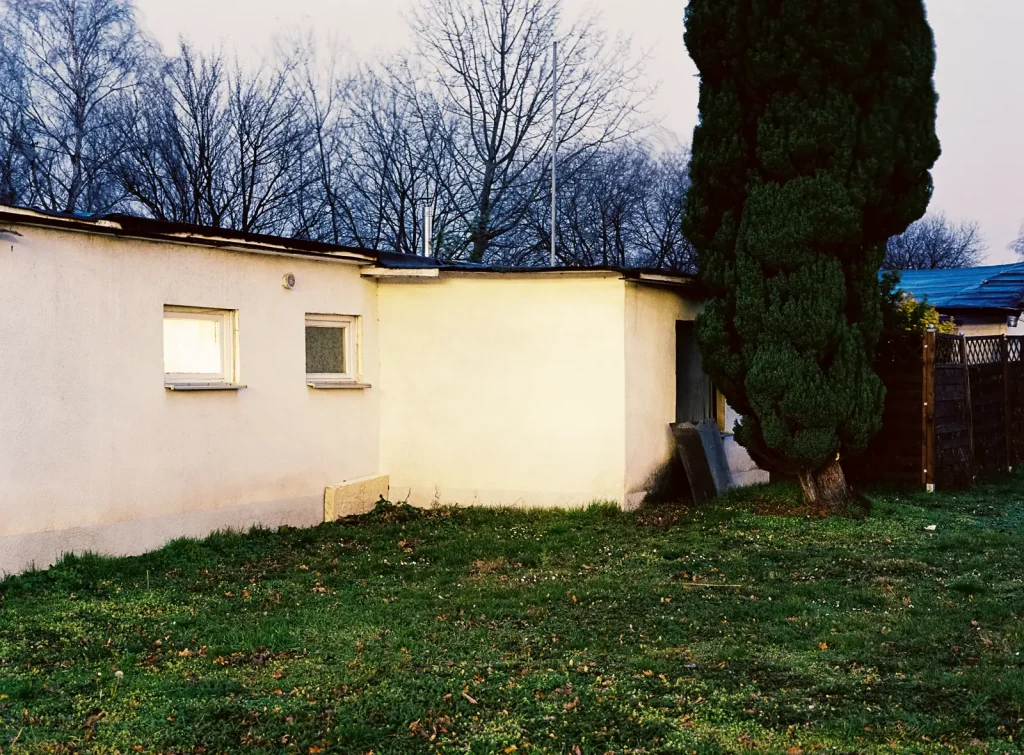
Image #8: The One with the Blue Warehouse under a Green Sky
Another example for a strange color effect I never would have imagined when I was taking the shot. As far as I remember the evening, exposing this frame was a test of patience. I walked from the tram station into a small business park and encountered this rather unpretentious scene. However, the warehouse seemed worth a photo. I particularly liked the markings on the ground leading towards it.
After I had opened the shutter, doubts arose. This long-time exposure would demand at least 15 minutes of the precious evening. Would these minutes be a good investment? Or did I squander my time? Think about this: night photography is often so time-consuming, that I consider a trip as success even if I return home with only two or three images. Because of this, I try to act especially thoughtful when out in dark. Scout first, shoot later. – As I received the scans from my lab, I was happy I had taken the shot.
Equipment: Leica Leicaflex SL2, PA-Curtagon 35mm f/4
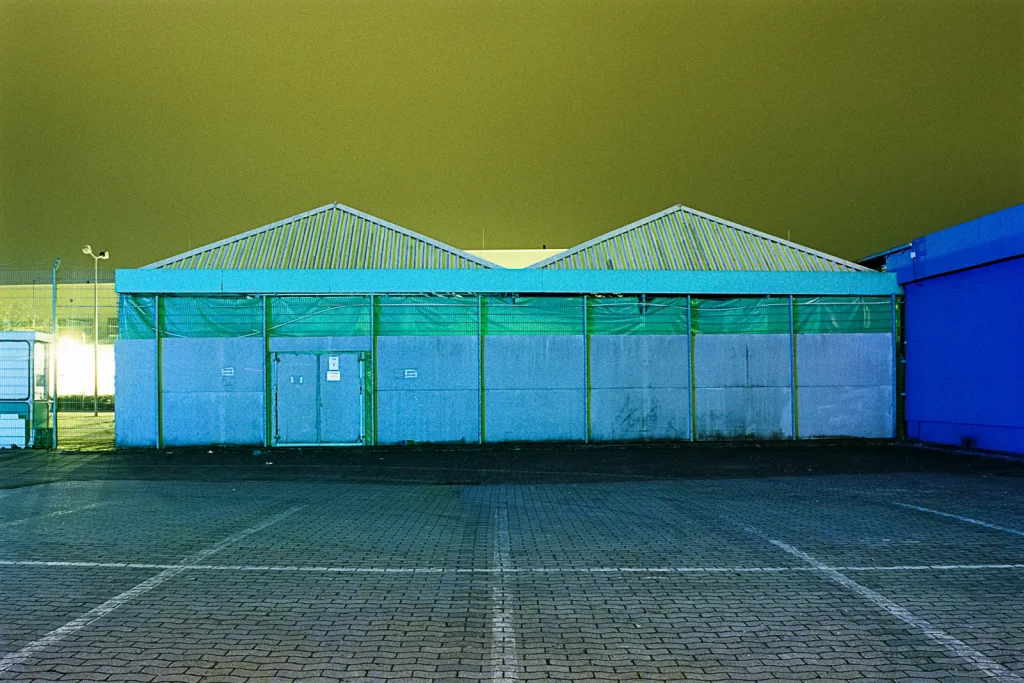
Image #9: The One with the Former Power Station
This image depicts the powerhouse of a former coal-fired power station. As I arrived there, I could hardly believe my luck. The full moon illuminated the facade, with a clear, starry sky above the building. I quickly scouted a suitable position, set up the tripod and opened the shutter. My intentions were to get the powerhouse in an angled perspective, decorated with the dark pines, the radio mast un-clipped and at least a small strip of water for possible reflections.
Unfortunately, I enjoyed this view too early. Less than five minutes into the exposure, clouds began to roll in. They soon blocked the moon and brightened the whole sky. Damn it! But I could already see the next large cloud hole in the distance. I was thinking feverishly. Wait until the moon is free again and then start a new exposure immediately? Will the actual frame have obtained enough light to this point? Would it okay for me to sacrifice the first one? And how long might the upcoming cloud hole last? Open up the aperture all the way to f/4 and shorten the exposure time as much as possible? Catch any given photon?
In the end, the cloud hole never arrived. (This smooth matter really behaves unforeseeably!) So I extended the first long-time exposure to roughly 25 minutes. There was no second one.
Equipment: Leica Leicaflex SL2, PA-Curtagon 35mm f/4
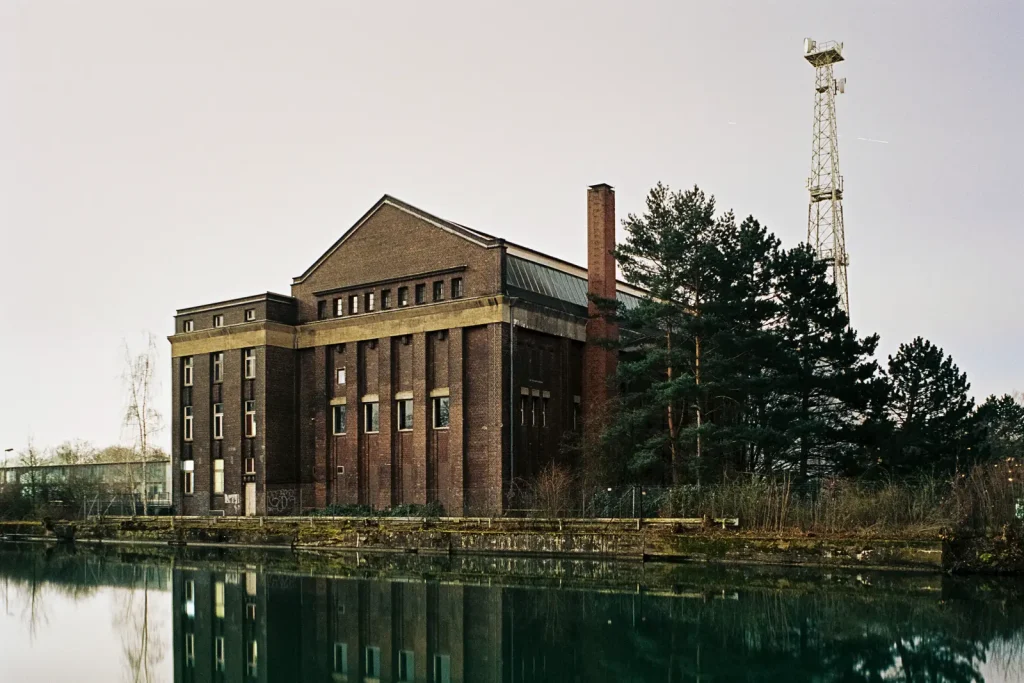
Image #10: The One with the Abandoned Rubber Factory
Tire manufacturer Continental shut down this factory back in 1999. Since then, the buildings have been attracting a lot of different people: graffiti and street artists, revellers, urban golfers, urban explorers, metal thieves, homeless persons, ordinary strollers – and, of course, photographers. Unfortunately, twenty years after the factory’s closure, most of the buildings and facilities have been demolished. The redevelopment of the area is finally underway.
I took the image from the opposite canal bank, standing hidden under a bridge. Handy, as passing rain showers wouldn’t have ruined the shot. A long-time exposure of notable 45 minutes revealed details invisible to the naked eye. There is also a single star: if you closely, you’ll discover its trail at the building’s rear end. By the way, the depicted section of the factory remains the last one standing. I guess you won’t find a single window with its glass intact. Nevertheless, it still exudes the pride of early 20th century industrial architecture.
Equipment: Leica Leicaflex SL2, PA-Curtagon 35mm f/4
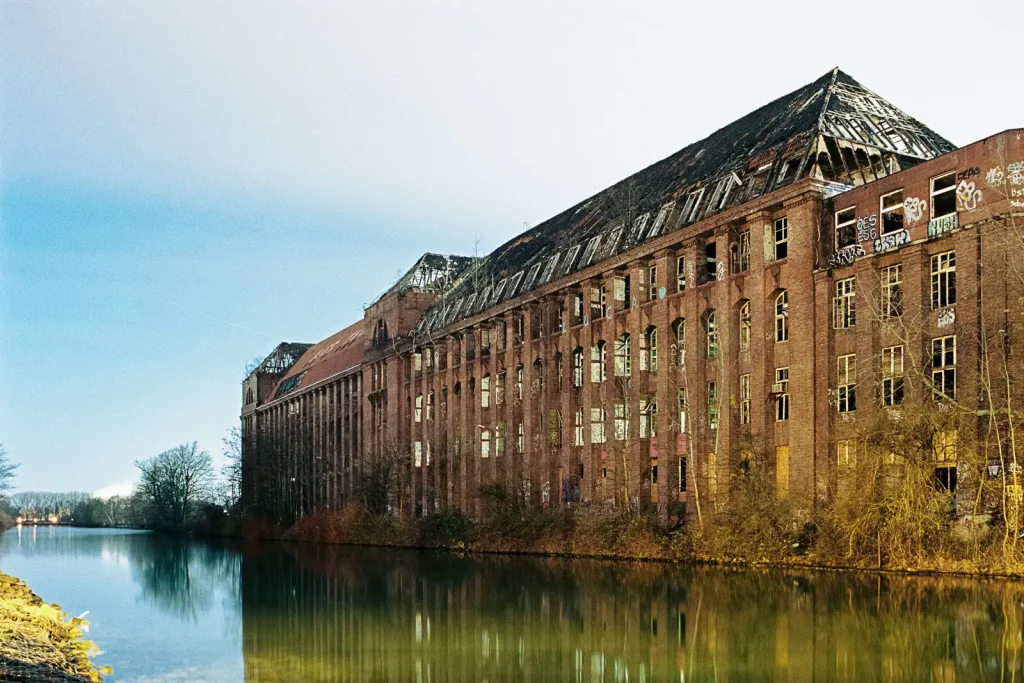
Image #11: The One with the Cool Ride
When we came home from a summer party, this old Ford stood round the corner. Such great American cars from a bygone era are a rare sight in Germany. Oh Boy! I feared the driver could return any second and my chance would have been gone forever. Back in our apartment, I hastily grabbed a camera and the tripod. I didn’t even get off my shoes. Lucky me, the efforts paid off. I took several shots from different angles, and this one is my favorite. Although (or because?) the car’s front was hidden in the shadows, the image came out nicely. Old wisdom: just expose for your subject.
Equipment: Leica M6, Summilux 50mm f/1.4
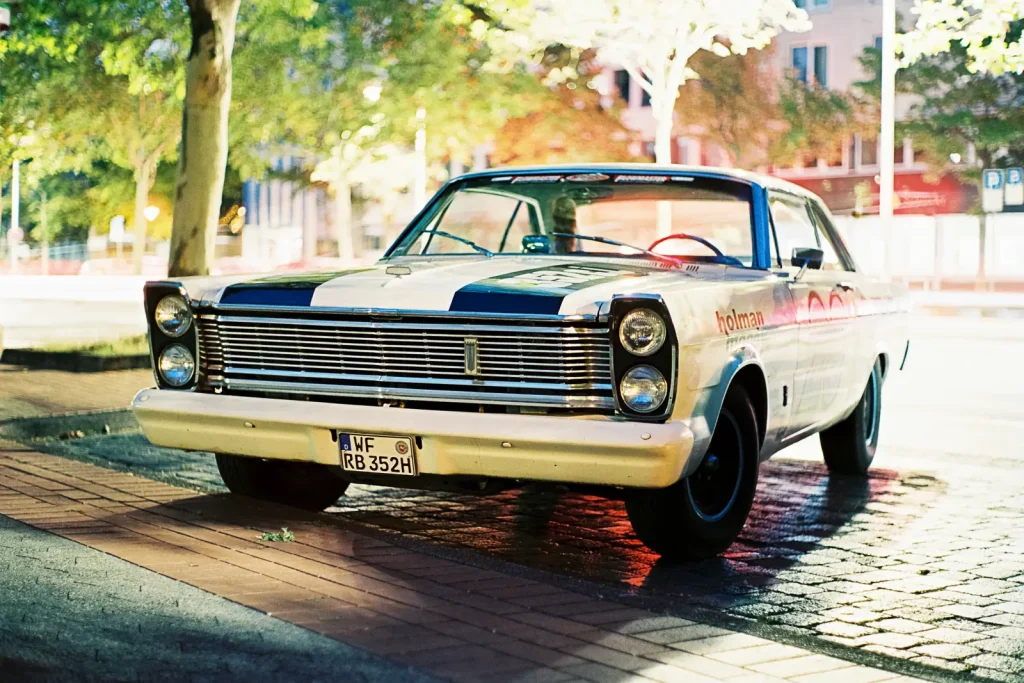
Image #12: The One with the Wrecked Scooter
This scooter: an invitation. The dead machine looked like someone had placed it deliberately in a way that I could take a good photograph. Sufficiently lit and in a tilted, dynamic position – what else can I ask for?
I discovered a run-down parking area behind a gas station, with several wrecked cars standing close to each other. At first, I hesitated. Two figures stood in dark backyard of gas station, chatting vividly. Normally, two talking men are nothing I would worry about. But under these circumstances, I felt like I would witness something I shouldn’t. And if I could see them, they would probably see me, too. What if they indeed made some shady deals? Fortunately, I could overcome my anxiety quickly. And of course, nothing happened. – By the way, the shining stripe in the background is responsible for the green windows in image #2.
Equipment: Leica Leicaflex SL2, Summicron-R 50mm f/2
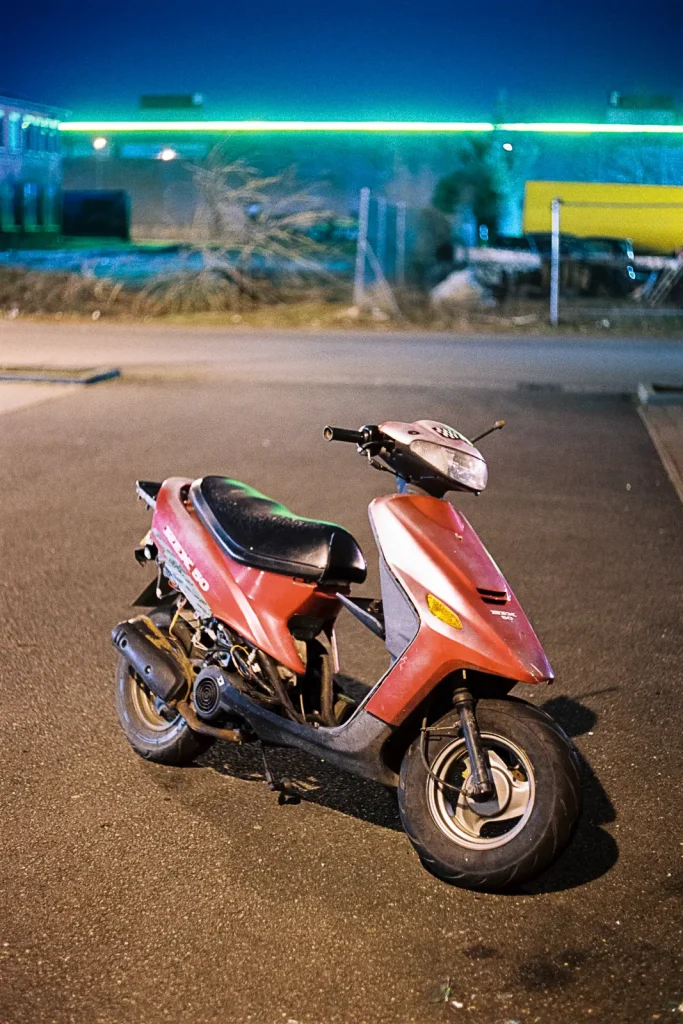
Image #13: The One with the Loading Crane
What a scary place! To get to the crane, I had to follow a long dead-end dirt road. One of the loneliest places at night I had discovered. Apart from me, the only other human beings around were the conductors of the nearby passing freight trains. And as the conductors sit inside large machines, they don’t really count…
Within this photograph, there are two things that give a hint to motion. One is the slightly blurry shovel of the crane. Obviously, the shovel swayed a little bit in the wind. The other thing are the faint star trails. I like them, as they are not only a decorative element, which breaks up a monotonous sky area. Star trails also prove that the photograph was actually taken at night. Long-time exposures under an overcast sky can lead to images that appear like day-time images at first glance – check image #9 and #18. And if you want to see intense star trails, check out Bill’s fantastic photographs from Australia!
Equipment: Hasselblad 500C, Zeiss 80mm f/2.8
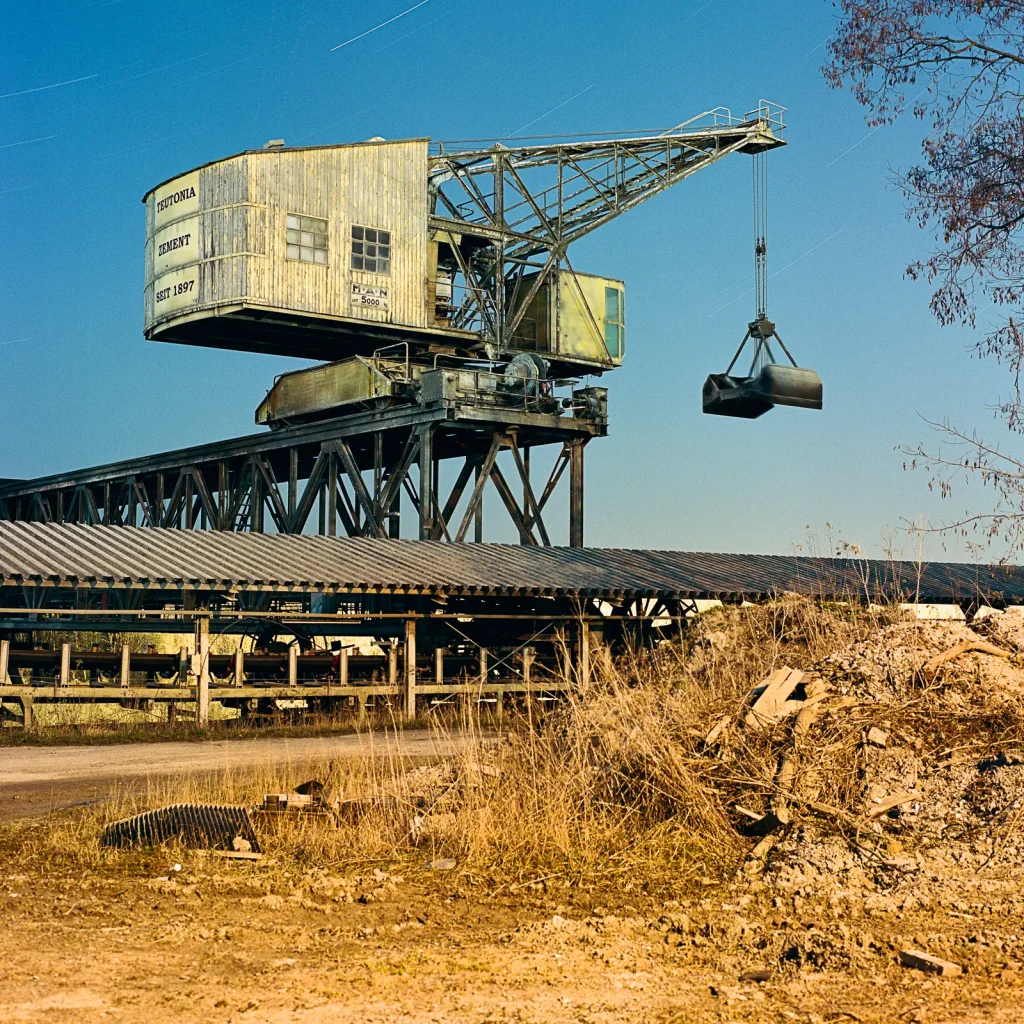
Image #14: The One with the Ships
My best friend from school now lives in Luxembourg and we don’t see each other very often anymore. So we decided to spend a short vacation together. We chose Amsterdam as it is an interesting city not too distant to both of other homes. Meet me halfway.
On the evening of the first day, my friend and I took the ferry from the central train station to NDSM. Until 1979, this used to be the terrain of a shipbuilding company. I would describe the site now as a young urban and artsy place. But the former industries haven’t vanished entirely yet. Still on the ferry, I spotted some ship repair activities nearby. We HAD to go there! Though my friend wasn’t overly enthusiastic about the long foot march, I didn’t cave in.
I took the photograph from the closest accessible point: with the lens stuck in a mesh of the fence. It is the only image in this article I took without a tripod – admittedly, not a true long-time exposure. Thank god I had chosen Portra 800 for this trip! (Well, as we met there in December, everything else would have been stupid.) I dialed in a of 1/15th of a second and hoped for the best.
Equipment: Leica Leicaflex SL, Summicron-R 50mm f/2
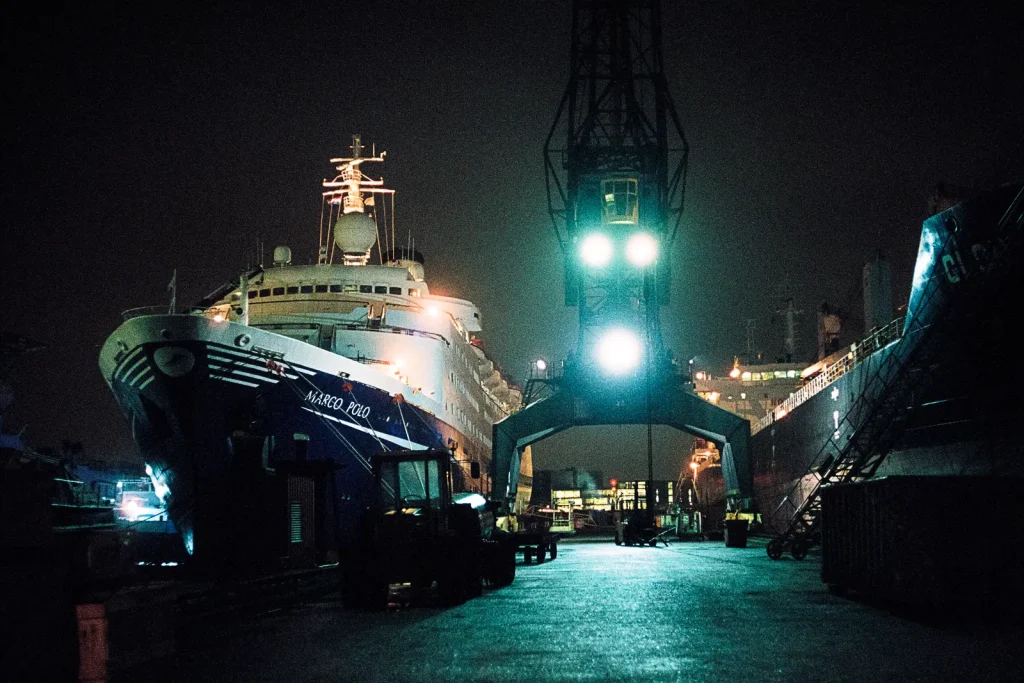
Image #15: The One with the Car Carpet Vacuum Cleaners
These two vacuum cleaner stations caught my attention as they were perfectly lit by a nearby spotlight. I chose a rather low camera position to let them appear like sculptures.
About two minutes into this long-time exposure, a strange man approached me. He hauled large shopping bags in both his hands. To save my image, I quickly put the cap in front of the lens. But the fella wasn’t interested in me at all – he just searched the waste bin for returnable bottles. What puzzled me: the guy did this with an extreme calmness, right in front of my camera less than two meters away. He behaved like I was invisible. Balls of steel.
Equipment: Leica Leicaflex SL2, PA-Curtagon 35mm f/4
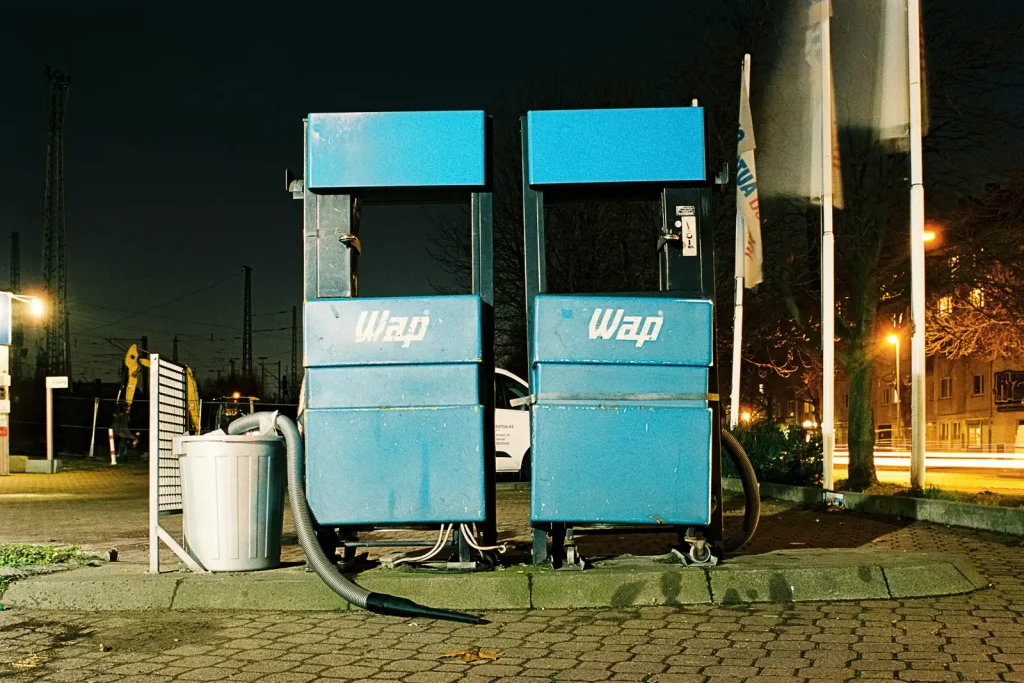
Image #16: The One with the Sports Field
After a day in the office with the usual routine, I was eager to leave the apartment in the evening. At least a short walk, this will do me well!, I thought. And maybe I’ll even find a good photo? I started out in the direction of the football stadium. In its vicinity, there are numerous sports fields, running tracks and training facilities.
A swimming hall caught my attention. My eyes dove into a long window hinge: the interior appeared brightly lit and with an intense blue of the pool. A men’s team was currently exercising water ball. I stood outside for a minute, admiring. However, I abandoned my plans to take a photo as I didn’t want to be held for a voyeur. When I turned around, I saw how the hall illuminated its surroundings. In the end, I got my opportunity.
Equipment: Leica Leicaflex SL2, PA-Curtagon 35mm f/4
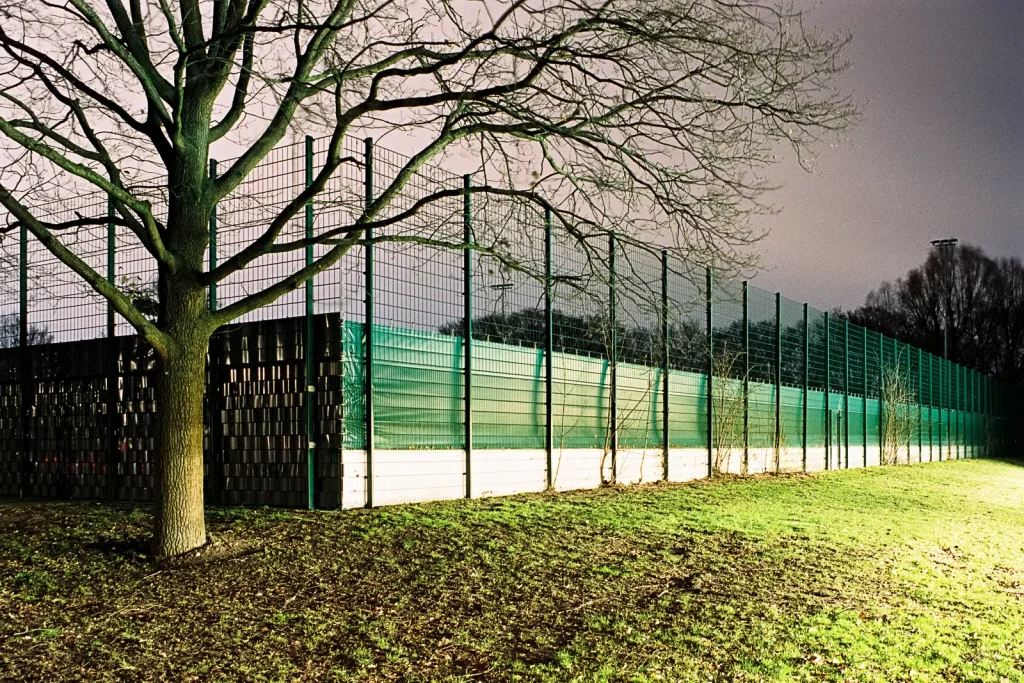
Image #17: The One with the Canal Bridge
This bridge was a “lucky highwayman”. I had taken some photographs of a nearby factory during dusk. The light was gone, high time for dinner. With my equipment properly stowed inside my backpack, I rushed back to the tram station. After I had already passed the bridge, I thought: “Damn it! I have to have it.”
Well then… Walk back, un-pack the camera, set up the tripod. The usual routine. But I hadn’t expected heavy traffic on the waterway. About five or six barges came along during this long-time exposure of 20 minutes. Seconds before a ship would enter my frame, I put on the lens cap. With this approach, I prevented light streaks cutting through my image. I like how the long-time exposure smoothened the water surface.
By the way, I didn’t like the photographs of the factory mentioned in the beginning. Not even one – and the factory had been the sole reason for this trip. C’est la vie. The long-time exposure of the bridge turned out to be my only keeper from this evening.
Equipment: Leica Leicaflex SL2, PA-Curtagon 35mm f/4
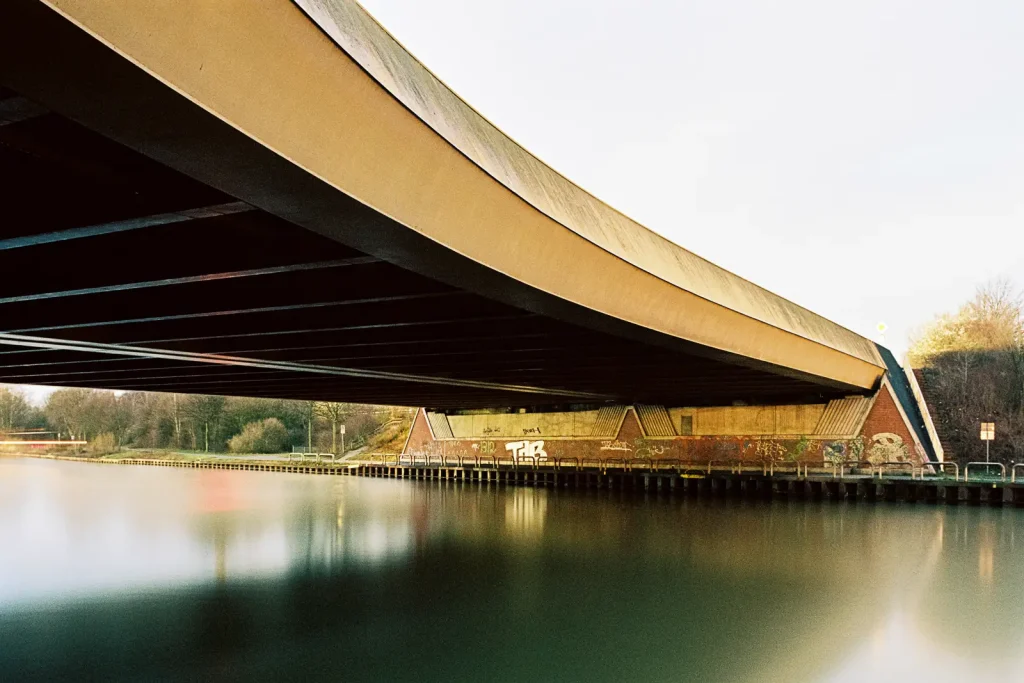
Image #18: The Final One
One these shots that neither look like day nor night. A bridge from the age of industrialization on a grey, overcast day. But hey, look again! Why is the water so calm? And why are the shadows so dark?
While I exposed for this frame, clouds were passing through. From time to time, the moon broke through and lit the steel beams. Each time, the moonlight didn’t last longer than 30 seconds. Inside my head, I cheered the old fella: “Come on! Come on! Stay with me!”
It was my last shot of this evening, with the other two ones shown here as image #9 and #10. At about 9:30 pm, I was running out of time. I had promised my girlfriend to be home not (considerably) later than 10 pm, so I had to catch the next bus. The promise left me with not more than 15 minutes for this long-time exposure. While the minutes passed, I was texting with a friend. In his company, a colleague had been tested positively. “Now I’m involved, too.”, my friend wrote.
I took this image on March 10th. It remains the last image before the pandemic, the last one I had taken outside my apartment.
Equipment: Leica Leicaflex SL2, PA-Curtagon 35mm f/4
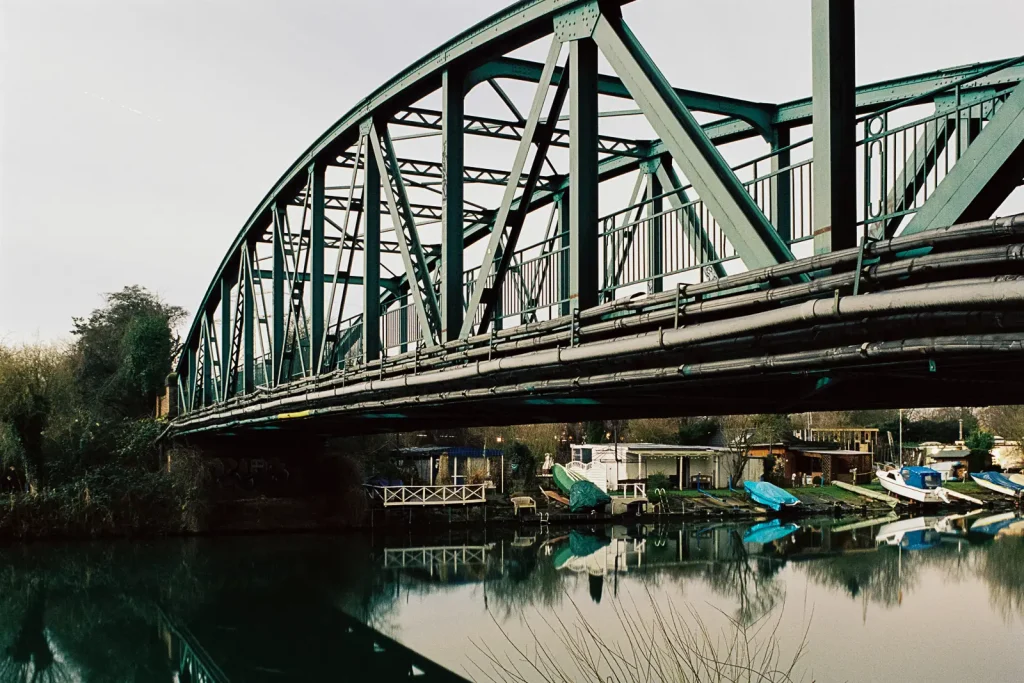
If you have made it that far: respect ! Thanks for reading.
Share this post:
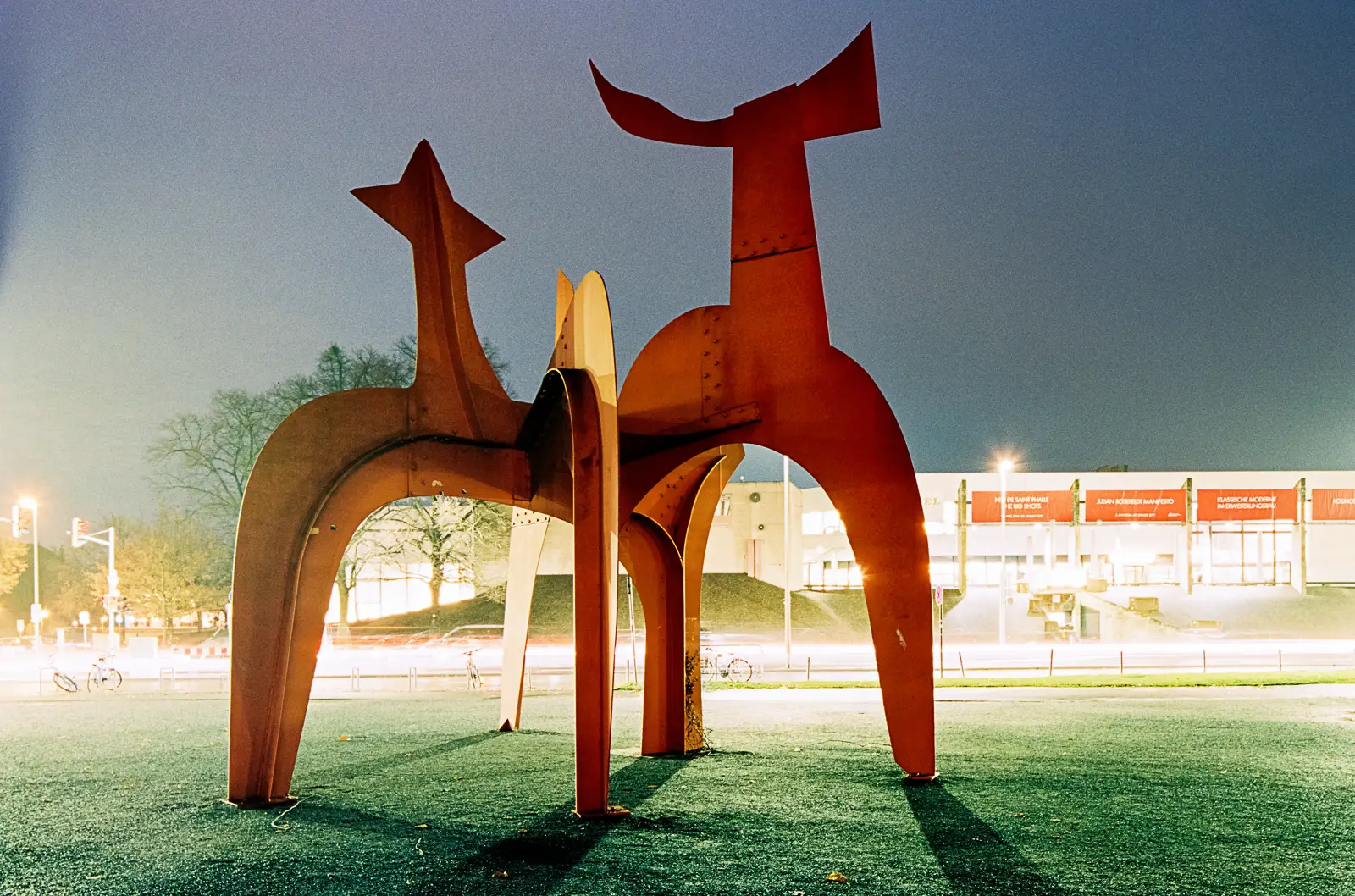








Comments
LEO on Yet Another Night Shift: Long-Time Exposures on Kodak Portra – by Christian Schroeder
Comment posted: 26/05/2020
Comment posted: 26/05/2020
Rock on Yet Another Night Shift: Long-Time Exposures on Kodak Portra – by Christian Schroeder
Comment posted: 26/05/2020
Comment posted: 26/05/2020
Matthias on Yet Another Night Shift: Long-Time Exposures on Kodak Portra – by Christian Schroeder
Comment posted: 26/05/2020
My faves are #4 (for me the best one), #5, #11 and #13.
#13 is really strange, looks like sunhine but is a night shot.
I'm really looking forward to your next post, don't let the pandemic stop you to take pictures.
All the best wishes
Matthias
Comment posted: 26/05/2020
les sarile on Yet Another Night Shift: Long-Time Exposures on Kodak Portra – by Christian Schroeder
Comment posted: 26/05/2020
Comment posted: 26/05/2020
Comment posted: 26/05/2020
Comment posted: 26/05/2020
Piper M on Yet Another Night Shift: Long-Time Exposures on Kodak Portra – by Christian Schroeder
Comment posted: 27/05/2020
Comment posted: 27/05/2020
Bent_Brent on Yet Another Night Shift: Long-Time Exposures on Kodak Portra – by Christian Schroeder
Comment posted: 27/05/2020
Please talk me through that very first image of the sculpture on the lawn; how did oyu go about metering that, with the strong backlight, without just ending up with a featureless slihouette?
And now that you've got so many more shots under your belt, do you still use a meter on most shots or do you find that these days, it's easier to just go by feel?
Comment posted: 27/05/2020
Fabian on Yet Another Night Shift: Long-Time Exposures on Kodak Portra – by Christian Schroeder
Comment posted: 27/05/2020
Comment posted: 27/05/2020
Comment posted: 27/05/2020
les sarile on Yet Another Night Shift: Long-Time Exposures on Kodak Portra – by Christian Schroeder
Comment posted: 27/05/2020
Mark V. on Yet Another Night Shift: Long-Time Exposures on Kodak Portra – by Christian Schroeder
Comment posted: 28/05/2020
I'm now semi-retired, & would like to start taking photo's again.
I have a couple Nikon FM's & recently bought a Pentax 6x7. I would like to do some night photography. I was thinking of starting out with black& white film. How do you meter for night exposures? I have a app on my phone,& also an old Luna Pro meter. I have a general idea for B&W film, but color film can be tricky.
Comment posted: 28/05/2020
Click Here on Yet Another Night Shift: Long-Time Exposures on Kodak Portra – by Christian Schroeder
Comment posted: 27/12/2020
to understand this topic. You realize so much its almost tough to argue with you (not that I really will need to…HaHa).
You certainly put a new spin on a subject which has
been discussed for many years. Great stuff, just excellent!
Comment posted: 27/12/2020
Bill Brown on Yet Another Night Shift: Long-Time Exposures on Kodak Portra – by Christian Schroeder
Comment posted: 28/02/2021